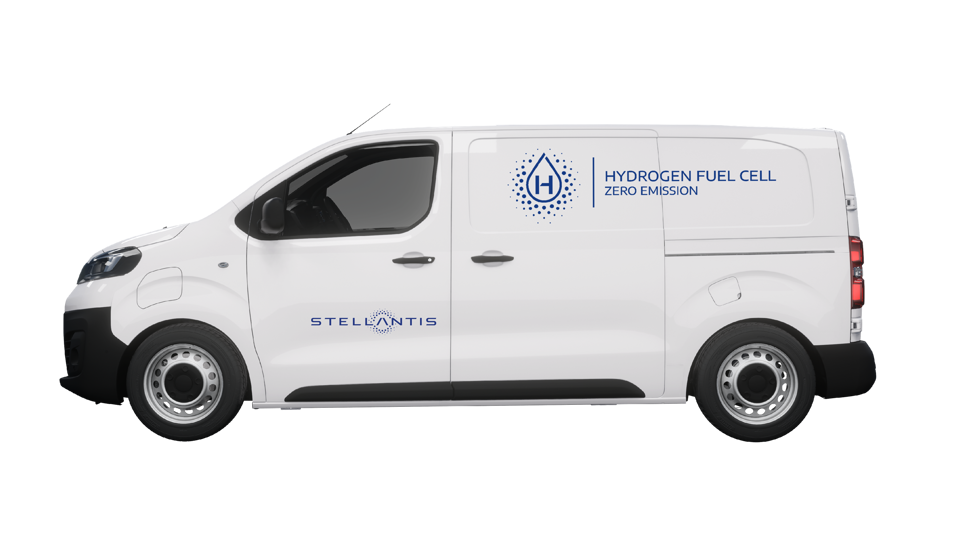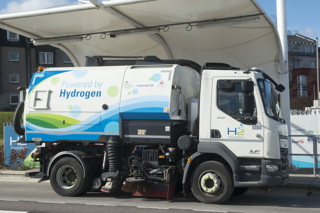Van-makers are looking at whether hydrogen could provide commercial fleet operators with the range and payload to successfully make the switch to electric.
Currently, electric operators have the choice of 18 vans, which qualify for the plug-in van grant. Small electric vans, less than 2.5 tonnes, include the Nissan e-NV200 and Renault Kangoo ZE, while in the mid to heavy van sector, the Vauxhall Vivaro-e, Mercedes-Benz eVito and Renault Master ZE are among a growing list of plug-in alternatives.
However, range, refill times and the impact of batteries on payload are restricting their deployment and use by some fleets.
Hydrogen could provide the answer, according to Stellantis (the new parent name for the merged PSA and FCA groups), which has announced it will launch three hydrogen plug-in hybrid, zero-emission vans based on the existing Citroën Dispatch, Peugeot Expert Partner and Vauxhall Vivaro.
Carla Gohin, senior vice-president of research and innovation at Stellantis, believes that for vans, battery electric propulsion is not the answer for all applications.
Fleets, she said, wanted “zeroe mission, long-range solutions”, which still allowed for the transportation of large and heavy items by protecting their payload.
Furthermore, she acknowledged that charging times needed to be much shorter, because the operational model of many fleets does not allow for the subsequent downtime.
Hydrogen hybrid power
Gohin explained: “Given these boundary conditions, it was a logical consequence to direct our research and development efforts towards a hydrogen fuel cell electric vehicle for first applications on light commercial vehicles as a complimentary solution for battery electric propulsion.”
It is designed to mix power sources, like a petrol or diesel hybrid, so the battery provides power from a standstill, at low speeds and under acceleration, while the hydrogen fuel cell takes over as the speed increases when less energy is needed.
As with an electric vehicle (EV), the system recoups energy back into the battery when coasting or decelerating.
“We’ve designed a mid-power architecture fuel cell system, combining the advantages of both hydrogen and battery technology,” said Gohin.
“The hydrogen provides the energy needed for long driving range. Whereas, the additional small battery provides the power for dynamic performances.”
The vehicles can store 4.4kg of liquid hydrogen in chassis-mounted tanks, while a rechargeable 10.5kWh battery is housed under the seats.
As a result, the hydrogen van offers the same payload and cargo volume as the equivalent internal combustion engine (ICE) model (up to 1,100kg and 6,100 litres respectively).
Stellantis says the hydrogen tank can be refilled in just three minutes – similar to a diesel van – and the battery can provide a range of 30 miles on its own when fully charged, which takes about an hour. Together, the van has a total range of 250 miles.
With a kilogramme of hydrogen costing around £10, the 4.4kg tank would cost £44 to fill, with the 230-mile hydrogen range resulting in a cost of 19p per mile – slightly higher than a comparable diesel van.
Maximum power is 136PS and maximum torque is 192lb ft, giving the van a 0-62mph time of 15 seconds and a top speed of 81mph. It is capable of towing up to a tonne.
Sales in left-hand drive markets will begin before the end of the year, while the new powertrain will be offered in the UK in 2022.
In terms of cost, Gohin said pricing has still to be confirmed, but Stellantis is trying to keep costs as low as possible by using its existing van architecture and bringing in hydrogen experts to accelerate its development.
Stellantis has entered into strategic partnerships with Faurecia and Symbio for the development of the fuel cell stacks and the storage system.
It is also focusing on total cost of ownership (TCO) and trying to attract as many businesses on board from the start to help reduce costs.
The Stellantis announcement comes after Renault revealed it was also developing a range of hydrogen vans, with hydrogen fuel cell specialist Plug Power.
The partnership aims to provide turnkey fuel cell vehicle solutions, fuel and refuelling infrastructure, targeting a 30% share of the fuel cell-powered van market in Europe.
Luca de Meo, CEO of Renault, says that it is the manufacturer’s ambition to position France as a “bridgehead of industrial, technical and commercial development in this key technology”, and to become the “European leader” in fuel cell vans.
The initial focus will be on the heavy van segment, utilising the Trafic and Master vehicle platforms, and the first hydrogen powered vans are expected to be deployed on pilot fleets later this year.
Hydrogen fleet trials
Siemens Mobility introduced a dual-fuel hydrogen field services van to its fleet on a trial basis, in partnership with Aberdeen City Council, earlier this year.
The converted Renault Master has been fitted with a green hydrogen fuel tank for use in combination with conventional diesel fuel.
This allows it to achieve up to 180mpg in dual-fuel mode, with diesel-only operation available as a back-up.
It takes less than 10 minutes to refuel with hydrogen, which is produced from renewable energy sources and reduces carbon emissions.
Meanwhile, hydrogen fuel conversion specialist ULEMCo is leading a Government-backed project to deliver a zero-emission Ambulance for the London Ambulance Service (LAS).
ZERRO – the Zero Emission Rapid Response Ambulance – is expected to be delivered by the autumn in prototype form.
The vehicle incorporates a hydrogen fuel cell range extender with an electric drive, low frame chassis and bespoke lightweight ambulance body designed and manufactured by Woodall Nicholson Group’s Mellor, Promech Technologies and VCS.
Working with ULEMCo and LAS are Lyra Electronics, which will provide DC-DC electronics capability, and Ocado, which has experience of light-weighting and the practical use of EVs.
Hydrogen refuelling stations
Hydrogen refuelling stations are still scarce across Europe, but the new models from Stellantis have received direct funding from the German government for their development, and are backed by a multi-billion Euros investment in EU hydrogen charging infrastructure being rolled out by French and German governments ahead of the EU’s target for carbon neutrality in 2050.
Currently, there are 25 hydrogen refuelling stations in France and 90 in Germany, with more being added every month. The UK has 14 hydrogen refuelling stations, according to UK H2 Mobility.
The majority are in the south of England, with two in Wales, two in Scotland and one in the north of England.
The Government committed £3 million of funding to kickstart the launch of a hydrogen transport hub in Tees Valley in March.
The site, which is expected to be fully operational by 2025, will be used to research and trial hydrogen-powered transport solutions.
By creating real-world hydrogen transport pilots, the Government hopes to better understand the role hydrogen has in meeting its 2050 net-zero ambitions.
Pop-up trials could see shops, supermarkets, online retailers, warehouse operators and delivery companies using hydrogen-powered transport to move goods and carry out last-mile deliveries.























Login to comment
Comments
No comments have been made yet.